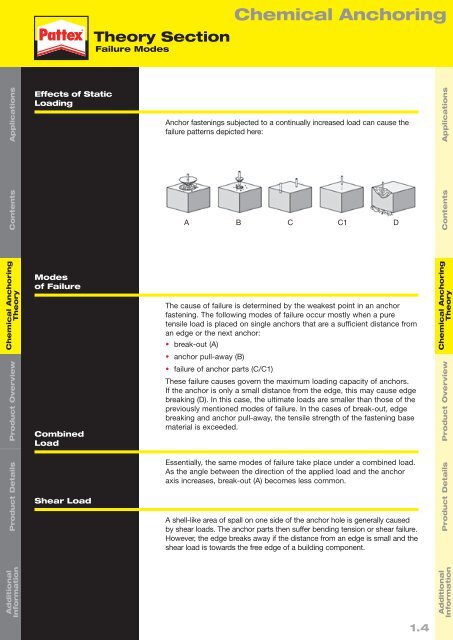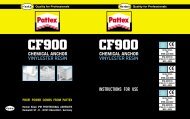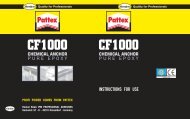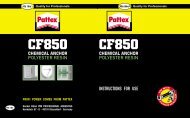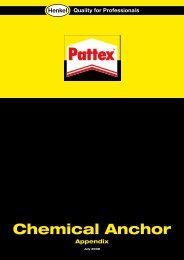Chemical Anchor Technical Handbook
Chemical Anchor Technical Handbook
Chemical Anchor Technical Handbook
You also want an ePaper? Increase the reach of your titles
YUMPU automatically turns print PDFs into web optimized ePapers that Google loves.
Theory Section<br />
Failure Modes<br />
<strong>Chemical</strong> <strong>Anchor</strong>ing<br />
Contents Applications<br />
<strong>Chemical</strong> <strong>Anchor</strong>ing<br />
Theory<br />
Product Overview<br />
Effects of Static<br />
Loading<br />
Modes<br />
of Failure<br />
Combined<br />
Load<br />
<strong>Anchor</strong> fastenings subjected to a continually increased load can cause the<br />
failure patterns depicted here:<br />
A B C C1 D<br />
The cause of failure is determined by the weakest point in an anchor<br />
fastening. The following modes of failure occur mostly when a pure<br />
tensile load is placed on single anchors that are a sufficient distance from<br />
an edge or the next anchor:<br />
• break-out (A)<br />
• anchor pull-away (B)<br />
• failure of anchor parts (C/C1)<br />
These failure causes govern the maximum loading capacity of anchors.<br />
If the anchor is only a small distance from the edge, this may cause edge<br />
breaking (D). In this case, the ultimate loads are smaller than those of the<br />
previously mentioned modes of failure. In the cases of break-out, edge<br />
breaking and anchor pull-away, the tensile strength of the fastening base<br />
material is exceeded.<br />
Product Overview<br />
<strong>Chemical</strong> <strong>Anchor</strong>ing<br />
Theory<br />
Contents Applications<br />
Product Details<br />
Shear Load<br />
Additional<br />
Information<br />
Essentially, the same modes of failure take place under a combined load.<br />
As the angle between the direction of the applied load and the anchor<br />
axis increases, break-out (A) becomes less common.<br />
A shell-like area of spall on one side of the anchor hole is generally caused<br />
by shear loads. The anchor parts then suffer bending tension or shear failure.<br />
However, the edge breaks away if the distance from an edge is small and the<br />
shear load is towards the free edge of a building component.<br />
Additional<br />
Information<br />
Product Details<br />
1.4


